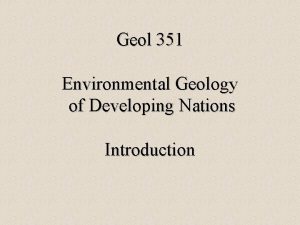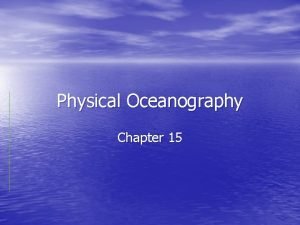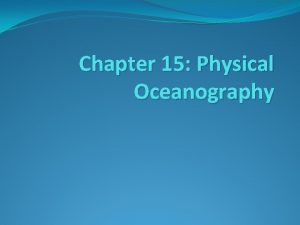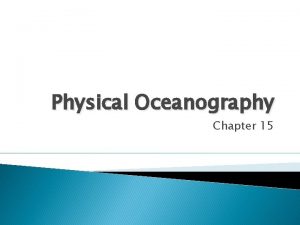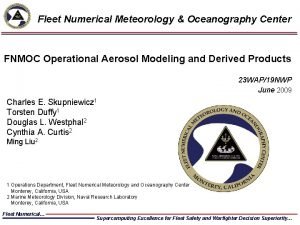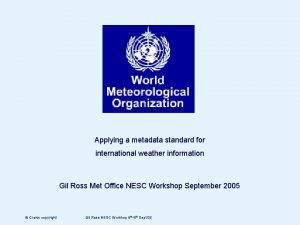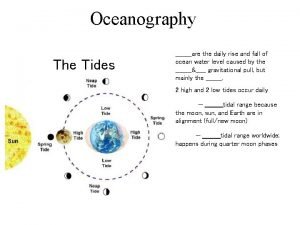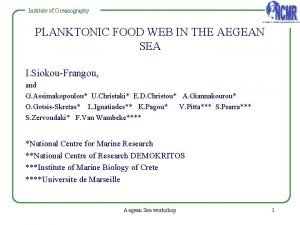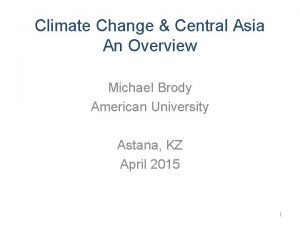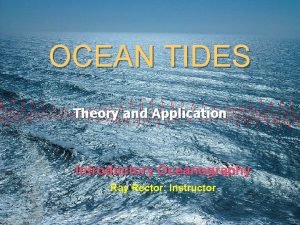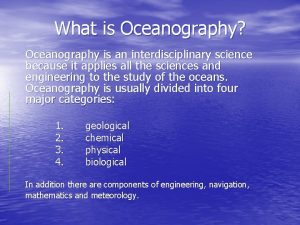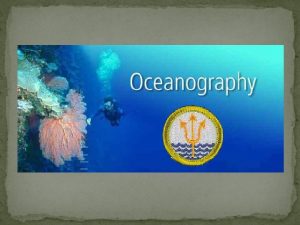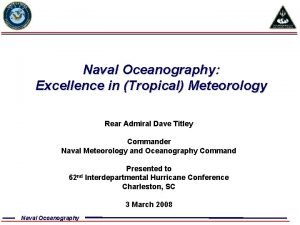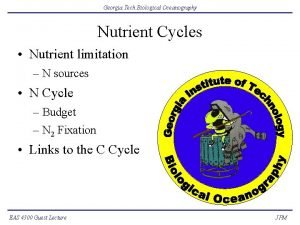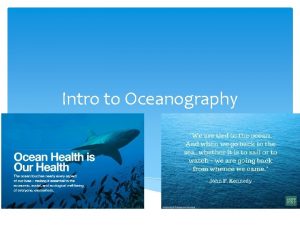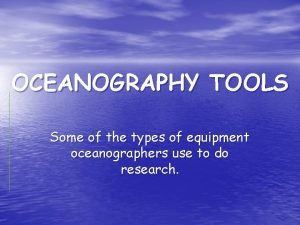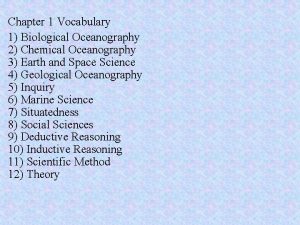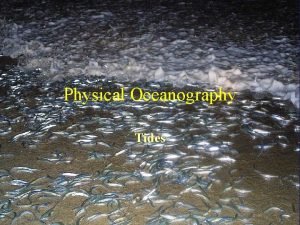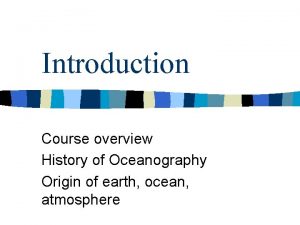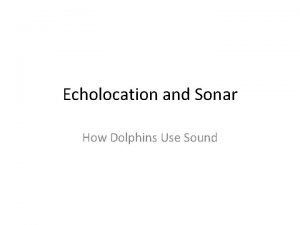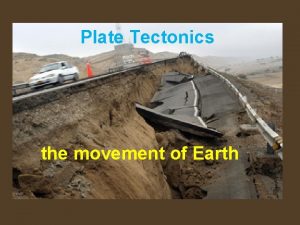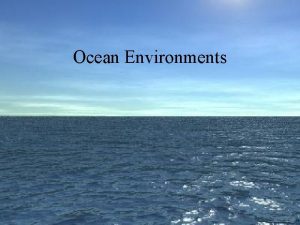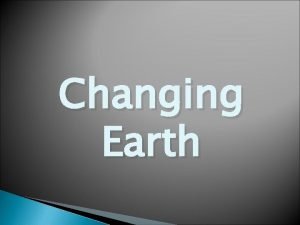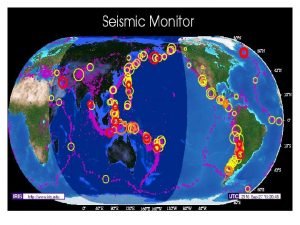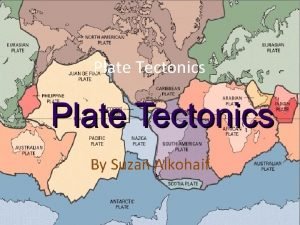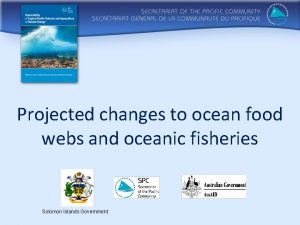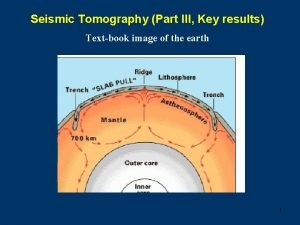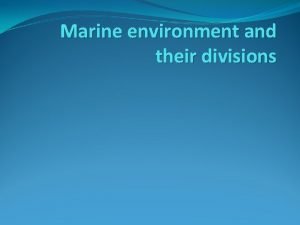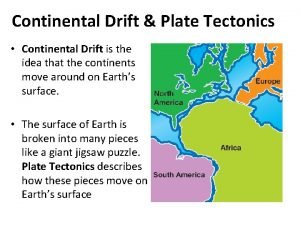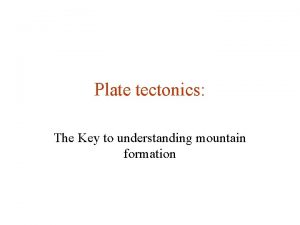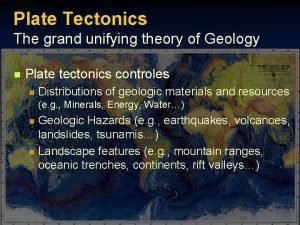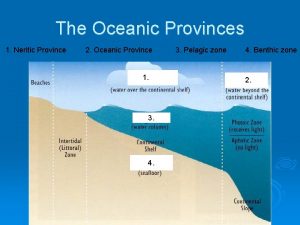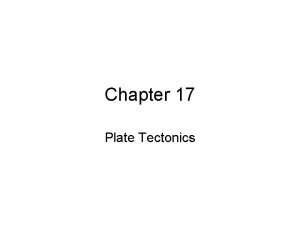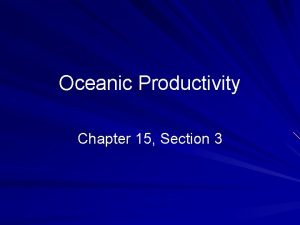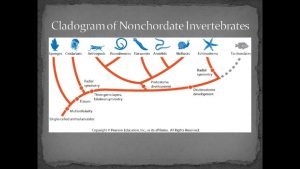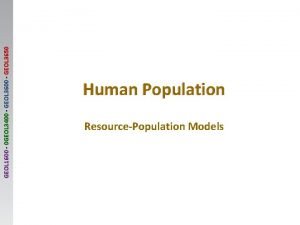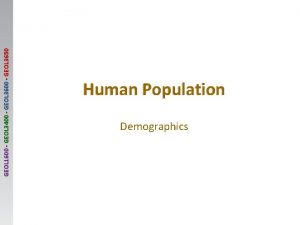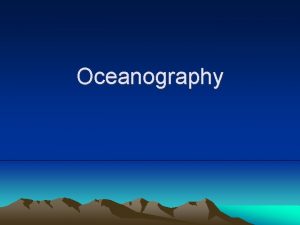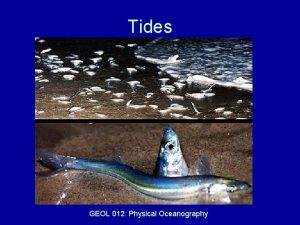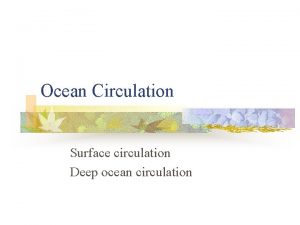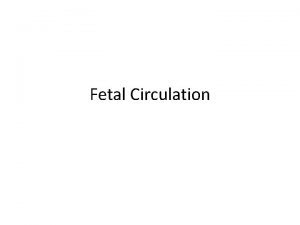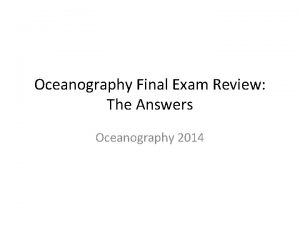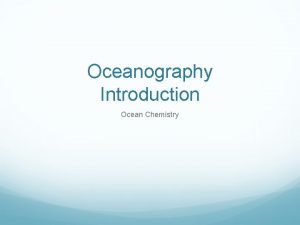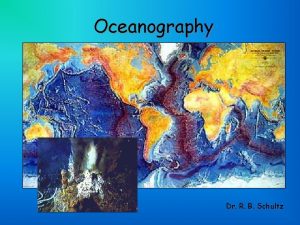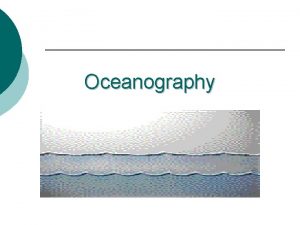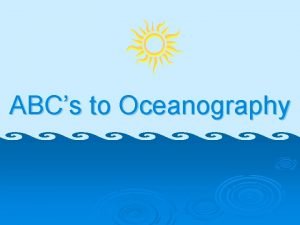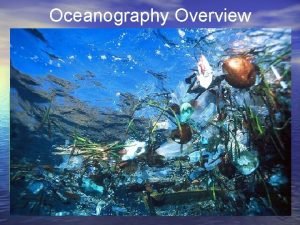Oceanic Circulation GEOL 12 Physical Oceanography Oceanic Circulation


































































- Slides: 66

Oceanic Circulation GEOL 12 Physical Oceanography

Oceanic Circulation 1. 2. 3. 4. 5. Surface Currents Effects of Surface Currents on Climate Upwelling and Downwelling Thermohaline Circulation Could the Day after Tomorrow Happen?

Our Dynamic Ocean Waters • About 10% of the water in the World ocean is involved in surface currents • Surface currents: water flowing horizontally in the uppermost 400 meters • Mainly driven by wind friction from Easterlies and Westerlies • Energy in the moving air is transferred to the water in the form of waves by friction • Water flowing beneath the wind forms a surface current

Ocean Circulation

Our Dynamic Ocean Waters • Because of the Coriolis effect, surface currents are deflected to the right of the wind direction in the Northern Hem. , and the left in the Southern Hem. • Continents and basin topography block continuous flow, and help to deflect the moving water into a circular pattern • This flow around the periphery of an ocean basin is called a gyre

Ocean Gyres From: Earth. usc. edu

Six Ocean Gyres • • • North Atlantic Gyre South Atlantic Gyre North Pacific Gyre South Pacific Gyre Indian Ocean Gyre Antarctic Circumpolar Current

Ocean Circulation

Major Currents within Gyres • Western Boundary – Fastest and deepest found along the western boundary of ocean basins (off the east coast of continents) • Eastern Boundary – Found along the eastern edge of ocean basins (off the west coast of continents) • Transverse currents – Currents that flow from east to west, and west to east, linking the eastern and western boundary currents

Ocean Circulation

Western Boundary Currents • Move warm water poleward in each of the gyres • 5 large western boundary currents: – Gulf Stream (in the North Atlantic) – Japan or Kuroshio current (in the North Pacific) – The Brazil current (in the South Atlantic) – The Agulhas current (in the Indian Ocean) – East Australian current (in South Pacific)

Ocean Circulation

Western Boundary Currents • Current as river analogy • Narrow (<100 km), deep (~2 km), swift (100’s km/day) • Water in current is usually warm and clear, depleted of nutrients, little or no coastal upwelling • Eddies often form that trap cold or warm waters in their centers and then separate from the main flow – Cold core eddies form in the Gulf Stream as it meanders eastward upon leaving the coast of N. America off Cape Hatteras (rotate counterclockwise) – Warm core eddies can form north of the Gulf Stream when the warm water current loops into the cold water lying north (rotate clockwise)

The Gulf Stream by Benjamin Franklin. (Courtesy of NOAA Photo Library. )

http: //www. iitap. iastate. edu

Eastern Boundary Currents • Carry cold water toward the equator • Shallow (<500 m) and broad (~1, 000 km), slow (10’s km/day) boundaries are not well defined and eddies tend not to form • Coastal upwelling common • Five eastern boundary currents: – – – The Canary current (in the North Atlantic) Benguela current (in the South Atlantic) The California current (in the North Pacific) The West Australia current (in the Indian Ocean) Peru or Humboldt current (in the South Pacific)

Ocean Circulation

Transverse Currents • Driven by winds • Major transverse currents – N and S Equatorial currents – N Pacific and N Atlantic currents – West Wind Drift (Antarctic Circumpolar current • Current carries more water than any other

Ocean Circulation

High latitude Currents • High northern Latitude currents – Greenland current – Laborador current – Alaska current • These currents form when larger currents are split and deflected by collision with a continent • Direction and rate of flow is controlled by the tendency of water to flow around objects rather than winds or the Coriolis force

Effects of Surface Currents on Climate • Along with winds, surface currents redistribute tropical heat worldwide • Western boundary currents yield warmer climates • Eastern boundary currents yield cooler climates – Mark Twain “the coldest summer I ever spent was in San Francisco”

Ocean Circulation

Wind Induces Vertical Circulation • When the wind driven horizontal movement of ocean waters induce vertical movement in surface water – Downwelling: downward movement of water – Upwelling: upward movement of water • • Equatorial upwelling Coastal upwelling

Equatorial Upwelling • Occurs in westward-flowing equatorial surface currents – Water moving on either side of the equator is deflected slightly pole ward and is replaced by deeper water • Brings nutrient rich waters to the surface • Long, thin band of upwelling and biological activity


The lighter blue areas represent higher phytoplankton biomass Map Courtesy of the National Oceanic and Atmospheric Administration

Coastal Upwelling • Wind blowing parallel to shore or offshore can cause coastal upwelling • The friction of the wind blowing along the ocean surface cases the water to move • The Coriolis effect deflects it to the right in the Northern Hem) and to the left (in the Southern. Hem) • Ekman transport moves it offshore

Ekman Transport • Ekman Spiral: the top layer of water is driven forward by the wind and each layer below is moved at an angle by friction and the Coriolis force • So surface waters tend to move 45° to the left in the southern hem or right in the northern Hem prevailing wind • Waters at depth will flow in the opposite direction to the surface current


Coastal Upwelling • The direction of Ekman transport is 90° to the right of the wind direction in the northern hemisphere and 90° to the left in the southern hemisphere Right

From Meteorology Ed And Training http: //meted. ucar. edu/

Oceanic Circulation 1. Surface Currents 2. Effects of Surface Currents on Climate 3. Upwelling and Downwelling

How do Oceanic density zones Relate to Ocean Circulation? • The slow circulation of waters at depth is driven by density differences not wind energy • This movement of water due to differences in density is thermo (heat) haline (salt) circulation= Thermohaline Circulation

What are water masses? • Water masses are water bodies that possess distinct, identifiable properties of: temperature and salinity • Do not mix easily due to their differing densities, so they flow above or below one another • Persistent, and will retain identity for long periods of time • Named according to relative position (vertically in the water column)

How do water masses relate to Thermohaline Circulation? • Density differences in water masses drive the deep ocean currents • The vertical motion of water masses from the surface to depth or visa versa is only possible where surface water density is similar to deep water density • Despite the churning of the surface ocean, the density differences of water masses makes the water column very stable

If water is sinking where is it rising? • Water sinks rapidly in a small area, but rises more gradually across larger areas = diffuse upwelling of deep waters – 1 cm (~½ inch) per day

Ocean Circulation

Could The Day After Tomorrow Really Happen?

Rapid Cooling New York

Polar melting has shut down the North Atlantic current

What drives the North Atlantic Current? 1. Winds push the warm salty current Eastward (Surface Current) 2. Density: as the water cools it sinks to the deep ocean (Thermohaline Current)

Warm, fresher water Cooler, Saltier Water Oceanography Students Conducting Ocean Circulation Experiment

How could Polar melting shut down the North Atlantic current?

Global Warming Source: http: //www. pik-potsdam. de/~stefan/thc_fact_sheet. html

Global Warming Sea Ice melting in North Atlantic Source: http: //www. pik-potsdam. de/~stefan/thc_fact_sheet. html

Global Warming Sea Ice melting in North Atlantic Freshening of the North Atlantic Source: http: //www. pik-potsdam. de/~stefan/thc_fact_sheet. html

Global Warming Sea Ice melting in North Atlantic Freshening of the North Atlantic Shut down the North Atlantic Source: http: //www. pik-potsdam. de/~stefan/thc_fact_sheet. html

Global Warming Sea Ice melting in North Atlantic Freshening of the North Atlantic Shut down the North Atlantic Europe and New York will get colder Source: http: //www. pik-potsdam. de/~stefan/thc_fact_sheet. html

Could The North Atlantic Current Shut Down?

Could The North Atlantic Current Shut Down? How would you answer this question? The Scientific Method

Could The North Atlantic Current shut down? A Problem or Question

Could The North Atlantic Current shut down? Hypothesis: Yes, the North Atlantic could shut down A Problem or Question Make a Hypothesis

Could The North Atlantic Current shut down? Hypothesis: Yes, the North Atlantic could shut down A Problem or Question Make a Hypothesis Test the Hypothesis

Could The North Atlantic Current shut down? Hypothesis: Yes, the North Atlantic could shut down A Problem or Question Make a Hypothesis Test the Hypothesis Prove it

Could The North Atlantic Current shut down? Hypothesis: Yes, the North Atlantic could shut down A Problem or Question Make a Hypothesis Test the Hypothesis Disprove it

Current Oceanographic Research about the North Atlantic Current: Ø 1997 Science 278 Ø 2000 Climactic Change 46 Ø 2003 Science 299 Ø 2003 WHOI Columbia Climatologist Wally Broecker developed the Theory of North Atlantic shut down Ø Dec. 2005 UN Climate Conference This guy looks a lot like…Wally.

Northern Hemisphere Temperature Increasing Black: instrumental record. Blue/red: climate proxies.

N. Hemisphere Sea Ice is Retreating Blue/black: observed data. Other colors: model data. (Vinnikov et al. , U. of Maryland)

The North Atlantic has been getting fresher WHOI 2003

But will this cause the North Atlantic Current to shut down? 1. 2005 Geophysical Research Letters Jacob et. al. a) Addition of freshwater to the North Atlantic →substantially weakened the NAC 2. 2005 Geophysical Research Letters 32 Schmittner et. al. a) Freshwater input in the North Atlantic → weakens the NAC by 30% after 100 years. b) All models simulate some weakening of the THC but no model simulates a shutdown.

Could The North Atlantic Current shut down? Hypothesis: Yes, the North Atlantic could shut down A Problem or Question Make a Hypothesis Test the Hypothesis Prove it Disprove it North Atlantic may slow down, NOT shut down

Could The North Atlantic Current shut down? Hypothesis: The North Atlantic will slow down. A Problem or Question Make a Hypothesis Test the Hypothesis Prove it Disprove it North Atlantic may slow down, NOT shut down

Could “The Day After Tomorrow” really happen? Hypothesis: The North Atlantic current will slow down A Problem or Question Make a Hypothesis Test the Hypothesis Prove it Theory or Model (not fact)

Could The Day After Tomorrow Really Happen?

Could The Day After Tomorrow Really Happen? Confirmed: üGlobal warming üPolar Ice Cap Melting üFreshening of the North Atlantic üSlowing down of the Thermohaline

Could The Day After Tomorrow Really Happen? Confirmed: Busted: üGlobal warming X North Atlantic Shut Down üPolar Ice Cap Melting X Temperature drop in a day üFreshening of the North Atlantic üSlowing down of the Thermohaline
 Oceanic oceanic convergent boundaries
Oceanic oceanic convergent boundaries Convergent oceanic oceanic plate boundary
Convergent oceanic oceanic plate boundary Geol 351
Geol 351 Settelünke geol
Settelünke geol Single circulation and double circulation
Single circulation and double circulation Single circulation and double circulation
Single circulation and double circulation Lung airway anatomy
Lung airway anatomy Chapter 15 physical oceanography
Chapter 15 physical oceanography Chapter 15 physical oceanography
Chapter 15 physical oceanography Chapter 15 physical oceanography
Chapter 15 physical oceanography Polynesians oceanography
Polynesians oceanography Fnmoc
Fnmoc Chemistry oceanography
Chemistry oceanography Oceanography
Oceanography Oceanography
Oceanography Oceanography
Oceanography Scripps institute of oceanography
Scripps institute of oceanography Branches of oceanography
Branches of oceanography Split institute of oceanography and fisheries
Split institute of oceanography and fisheries Photo search
Photo search Oceanography
Oceanography Essentials of oceanography
Essentials of oceanography Chemistry oceanography
Chemistry oceanography Is oceanography and interdisciplinary science?
Is oceanography and interdisciplinary science? Occacaris
Occacaris Oceanography
Oceanography Oceanography
Oceanography Chemistry oceanography
Chemistry oceanography Tools used in oceanography
Tools used in oceanography Chemical oceanography definition
Chemical oceanography definition Oceanography
Oceanography University of hawaii oceanography
University of hawaii oceanography History of oceanography
History of oceanography Institute of oceanography and fisheries
Institute of oceanography and fisheries Harta clima europei
Harta clima europei How do dolphins use sound waves
How do dolphins use sound waves Mid ocean ridge
Mid ocean ridge Aice environmental management
Aice environmental management Oceanic group
Oceanic group What happens when two oceanic plates collide
What happens when two oceanic plates collide Oceanic plate
Oceanic plate Convergent plate boundary
Convergent plate boundary Pelagic zones
Pelagic zones Oceanic or continental
Oceanic or continental Oceanic airlines 747
Oceanic airlines 747 Happens when two oceanic plates collide
Happens when two oceanic plates collide Intertidal ocean zone
Intertidal ocean zone Convergent boundary
Convergent boundary Oceanic crust
Oceanic crust Oceanic food webs
Oceanic food webs Oceanic crust age
Oceanic crust age Oceanic divisions
Oceanic divisions Mid oceanic ridge
Mid oceanic ridge The cross section below depicts magnetized oceanic crust
The cross section below depicts magnetized oceanic crust 7 lithospheric plates
7 lithospheric plates Real life divergent boundary
Real life divergent boundary Tuna food web
Tuna food web San andreas fault plate boundary
San andreas fault plate boundary Oceanic crust age
Oceanic crust age New york oceanic
New york oceanic Neritic province
Neritic province Lurazja
Lurazja Convergence of two oceanic plates oreo
Convergence of two oceanic plates oreo 15.3 oceanic productivity
15.3 oceanic productivity Pricing strategies in marketing
Pricing strategies in marketing Physical fitness grade 9
Physical fitness grade 9 Enchinoderma
Enchinoderma


